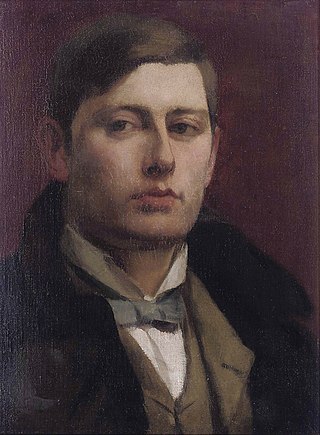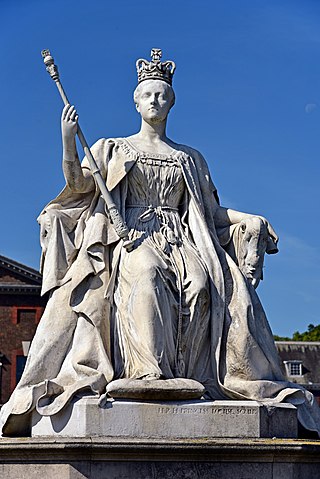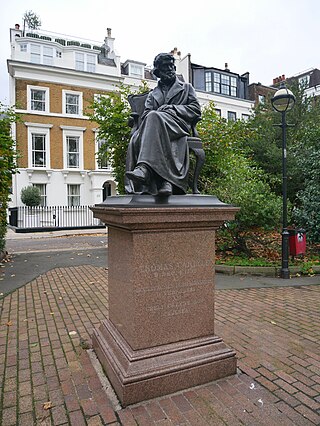
Sir Joseph Edgar Boehm, 1st Baronet, was an Austrian-born British medallist and sculptor, best known for the "Jubilee head" of Queen Victoria on coinage, and the statue of the Duke of Wellington at Hyde Park Corner. During his career Boehm maintained a large studio in London and produced a significant volume of public works and private commissions. A speciality of Boehm's was the portrait bust; there are many examples of these in the National Portrait Gallery. He was often commissioned by the Royal Family and members of the aristocracy to make sculptures for their parks and gardens. His works were many, and he exhibited 123 of them at the Royal Academy from 1862 to his death in 1890.

Sir George James Frampton, was a British sculptor. He was a leading member of the New Sculpture movement in his early career when he created sculptures with elements of Art Nouveau and Symbolism, often combining various materials such as marble and bronze in a single piece. While his later works were more traditional in style, Frampton had a prolific career in which he created many notable public monuments, including several statues of Queen Victoria and later, after World War I, a number of war memorials. These included the Edith Cavell Memorial in London, which, along with the Peter Pan statue in Kensington Gardens are possibly Frampton's best known works.

College Green is a public open space in Bristol, England. The Green takes the form of a segment of a circle with its apex pointing east, and covers 1.1 hectares. The road named College Green forms the north-eastern boundary of the Green, Bristol Cathedral marks the south side, and City Hall closes the Green in an arc to the north-west.

Queen's Cross is an area in the West End of Aberdeen, Scotland. It is located just west of the main thoroughfare of Union Street and about 1.5 miles (2.4 km) from the geographical town centre at Mercat Cross.

Leeds Art Gallery in Leeds, West Yorkshire, England, is a gallery, part of the Leeds Museums & Galleries group, whose collection of 20th-century British Art was designated by the British government in 1997 as a collection "of national importance". Its collection also includes 19th-century and earlier art works. It is a grade II listed building owned and administered by Leeds City Council, linked on the West to Leeds Central Library and on the East via a bridge to the Henry Moore Institute with which it shares some sculptures. A Henry Moore sculpture, Reclining Woman: Elbow (1981), stands in front of the entrance. The entrance hall contains Leeds' oldest civic sculpture, a 1712 marble statue of Queen Anne.
Edward Alfred Briscoe Drury was a British architectural sculptor and artist active in the New Sculpture movement. During a long career Drury created a great number of decorative figures such as busts and statuettes plus larger monuments, war memorials, statues of royalty and architectural pieces. During the opening years of the 20th-century he was among the foremost architectural sculptors active in Britain and in that period created the series of works in central London for which he is perhaps now best known. These include the figures on the Old War Office building in Whitehall, elements of the facade of the Victoria and Albert Museum and four of the colossal statues on Vauxhall Bridge.

The Victoria Memorial is a large marble monument in the Maidan in Central Kolkata, having its entrance on the Queen's Way. It was built between 1906 and 1921 by the British Raj. It is dedicated to the memory of Queen Victoria, the Empress of India from 1876 to 1901.

Bristol High Cross is a monumental market cross said to have been erected c.1373 in the centre of Bristol, England, to commemorate the granting of a charter by Edward III to make Bristol a county, separate from Somerset and Gloucestershire. It was likely constructed on the site of an earlier market cross. The cross at it survives today is in Decorated Gothic style. In 1764 it was moved to the Stourhead estate in Wiltshire, where it still stands.

The Golden Jubilee Medal was instituted in 1887 by Royal Warrant as a British decoration to be awarded to participants of Queen Victoria's golden jubilee celebrations.

Francis John Williamson was a British portrait sculptor, reputed to have been Queen Victoria's favourite.

A bronze statue of John Bunyan stands on St Peter's Green, Bedford, England. The statue was sculpted by Sir Joseph Edgar Boehm, it was erected in 1874, and unveiled on 10 June of that year. The statue was commissioned by the Ninth Duke of Bedford and presented by him to Bedford town.

An equestrian statue of Arthur Wellesley, 1st Duke of Wellington, stands on the north side of Hyde Park Corner, London. The open space in which it stands, now the centre of a large roundabout, was once called Wellington Place.

A statue of Queen Anne is installed in the forecourt outside the west front of St Paul's Cathedral, in London, United Kingdom. It became a Grade II listed building in 1972.

The Sir Joseph Bazalgette Memorial is a memorial to the Victorian engineer Sir Joseph Bazalgette, by George Blackall Simonds. It is located on the Victoria Embankment, a few feet up river from the Hungerford Bridge and Golden Jubilee Bridges, opposite the junction with Northumberland Avenue.

The Thames Ditton Foundry was a foundry in Thames Ditton, Surrey, which operated from 1874 to 1939 and which under various owners produced numerous major statues and monuments as one of the United Kingdom's leading firms of bronze founders.

A statue of Queen Victoria stands near Kensington Palace. It was sculpted by Victoria's fourth daughter Princess Louise, Duchess of Argyll and erected in 1893. The statue was made from white marble on a Portland stone base. It depicts Victoria aged 18, seated in her coronation robes, resembling the painting of Victoria at her coronation by Sir George Hayter. The statue received a Grade II listing in 1969.

A bronze statue of Robert Stephenson by Carlo Marochetti usually stands on a red granite plinth in the forecourt of Euston railway station in London, England. Erected in 1871, it is one of few surviving elements of the original station after it was redeveloped in the 1960s, and it became a Grade II listed building in 1974. It was temporarily removed in 2020 to allow the station to be remodelled to accommodate the new High Speed 2 (HS2) railway line.

The Jubilee coinage or Jubilee head coinage are British coins with an obverse featuring a depiction of Queen Victoria by Joseph Edgar Boehm. The design was placed on the silver and gold circulating coinage beginning in 1887, and on the Maundy coinage beginning in 1888. The depiction of Victoria wearing a crown that was seen as too small was widely mocked, and was replaced in 1893. The series saw the entire issuance of the double florin (1887–1890) and, in 1888, the last issue for circulation of the groat, or fourpence piece, although it was intended for use in British Guiana. No bronze coins were struck with the Jubilee design.

A statue of Thomas Carlyle by Joseph Edgar Boehm stands in Chelsea Embankment Gardens in London. Erected in 1881 and unveiled in 1882, it stands close to 24 Cheyne Row where Carlyle lived for the last 47 years of his life. The statue became a Grade II listed building on 15 April 1969.

The Jubilee Memorial, Harrogate, is a Grade II listed building. It is a Gothic Revival stone memorial in Harrogate, North Yorkshire, England, commemorating the 1887 golden jubilee of Queen Victoria. It was donated to Harrogate by its mayor, Richard Ellis, designed by architect Arthur Bown, and unveiled by the Marquis of Ripon.



















